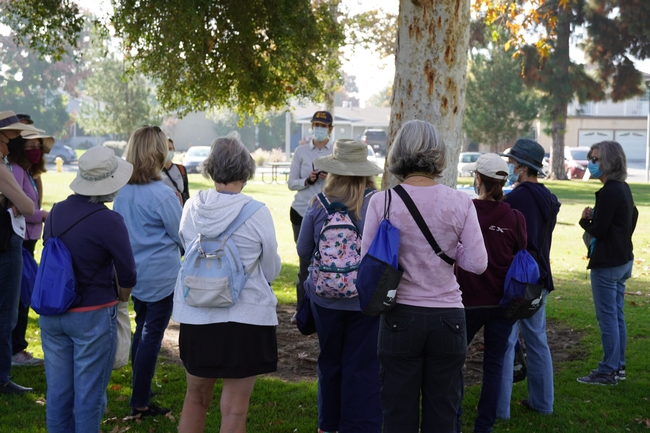UC ANR program trains volunteers to accurately identify and report infested trees, protecting forests and encouraging civic engagement through participatory science.
The Issue
Invasive pests are one of the main threats to our urban and natural forests. Tiny beetles, like the invasive shothole borers (ISHB), attack trees and cause their decline and death. Even though ISHB can have devastating effects to urban and natural forests throughout Southern California, many trees can still be saved with proper management, allowing infested areas to recover over time. Detecting infestations early is key for successful management of this pest and to prevent spread to new areas.
Participatory science can be a useful tool to identify ISHB-infested trees and help monitor high-risk areas throughout the state. However, accurately identifying the presence of ISHB is challenging because the beetles spend most of their lives within the tree, hence we must rely on signs and symptoms to determine if the tree is infested (to learn more, visit www.ISHB.org)
How UC Delivers
Given these challenges, we wanted to know if participatory science can still be a good tool to monitor for ISHB. We created a training program to teach volunteers how to identify ISHB-infested trees and evaluated how different training modalities can make volunteer's observations more accurate.
UCCE Urban Forestry Advisor, Beatriz Nobua-Behrmann, teamed up with the California Naturalist program to develop a reporting tool in iNaturalist and a six-hour training that included an online course, two workshops, and after-training office hours for follow-up questions. They ran two trainings: one fully online in October 2020, and one that included an in-person component in October 2021. A total of 34 participants were trained, including volunteers from the California Naturalist and the Master Gardeners programs, and other community members.
Each participant reported up to five ISHB-infested trees. Each report included descriptive data of the individual tree, level of infestation, geolocation, and pictures of the signs and symptoms observed. To evaluate the accuracy, first UC experts assessed each report and determined if the tree was probably infested or not based on the submitted pictures. Then, UC experts located and re-assessed the same trees in the field. The data collected by the volunteers was compared side-to-side with the data collected by the experts to evaluate the accuracy of volunteer-collected data.
The Impact
Participants of this program learned how to identify and report ISHB-infested trees and the importance of early detection to successfully manage invasive pests. Despite the challenges of correctly identifying infested trees, participants applied what they learned by submitting more than 122 reports of suspected infestations. After experts re-assessed the reported trees, we learned that volunteers collected overall high-quality data, but training modality seemed to make a substantial difference in the accuracy of the IDs. Volunteers who received in-person training were significantly more accurate (96% correct ISHB IDs) than the ones who received online training only (85% correct IDs).
Many program participants are now participating in the Master Gardeners Emerging Tree Pests Program and are sharing this information with the public, helping to create awareness in their community, demonstrating how UC ANR's civic engagement helps to protect California's natural resources.
All the incorrect IDs confirmed in the field were also previously flagged as possibly incorrect during the first evaluation of the reports from the pictures. This means that future quality control can safely rely on experts evaluating the pictures in the reports without having to re-evaluate the tree in person. Thanks to this study, we now know that community-based data can reliably contribute to the local and state-wide efforts to monitor the presence of ISHB, especially if in-person components are included in the trainings. Future steps of this program include delivering more trainings and using the data collected by the volunteers to inform the current ISHB distribution map available to the public. Having accurate information on the current distribution of ISHB throughout the state is an important decision-making tool for the agencies working on managing this pest, who need to determine where the infestation focuses are and how far away they are from other high-risk areas.
